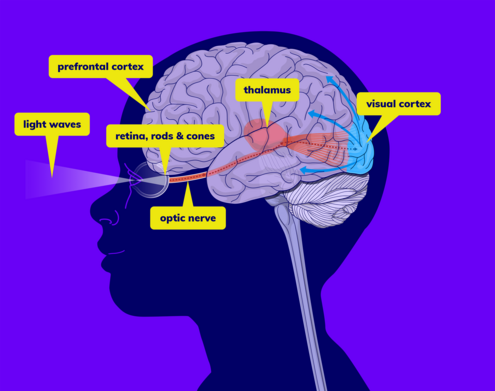Seeing Color
What happens when we see a beach ball? Find out in this video! It shows how color vision works by following a beam of sunlight as it bounces off a beach ball and enters a human eye. But our eyes are just the beginning—the real star of the story is the brain .
What happened?
Let’s go through the steps involved in seeing that beach ball:
- Notice all the colors on the beach ball? They come from different paints in the plastic. Light is made up of different wavelengths, or colors, and white light is a combination of all of them. When a ray of white sunlight hits a patch of beach ball, the paint absorbs most of the wavelengths. It reflects the rest. For example, if the patch is blue, it reflects the blue wavelengths and absorbs all the others.
- Those reflected light waves from the Sun bounce off the beach ball, right into your eye. That’s when the action starts.
- At the back of your eye is a tissue called the retina. Special cells called rods and cones live in the retina. These cells are the eye’s lookouts. Their job is to spot light and let the brain know about it. Different rods and cones react to different wavelengths, or colors, of light.
- When light hits the rods and cones, they send electrical signals to let the brain know. They do that through the optic nerve. Like roads and highways, nerves carry signals around the brain and body.
- The optic nerve is connected directly to a part of the brain called the thalamus. Like cards and packages arriving at a sorting station, signals come into the thalamus from many senses, not just sight. The thalamus processes those signals, combining and repackaging some of them into new information. Then it sends the information to other parts of the brain.
- Next, the information about the beach ball heads to the visual cortex. It’s an area way in the back of the brain that’s part of the occipital lobe.
- Special cells in the visual cortex are on the lookout for different kinds of visual information. For example, some of those cells react when the object is a circle. Others react when it’s a line. Some cells react to motion, some to color, and some to various other things. So when it comes to seeing the ball, specific cells recognize each color, and other cells recognize the round shape. These signals are combined into a whole image.
- Information about the beach ball’s image heads out along the nerves to other parts of the brain. One place it goes is an area in the front called the prefrontal cortex. The prefrontal cortex is behind the forehead and above the eyes. That’s where the brain processes information from the senses and combines it with other kinds of information, such as memories and emotions.
Together, all this information helps us make sense of the object. We see the beach ball’s round shape and all its colors. We can tell which direction it’s moving. We understand how hard to hit it to send it into our friend’s waiting hands. And we know when to put our own hands up to catch it. For us to perceive the beach ball, so many different parts of the brain all have to work together. Think fast!
These regions are shown in the following diagram:


The Museum gratefully acknowledges the Richard and Karen LeFrak Exhibition and Education Fund.
Generous support for The Nature of Color has been provided by the Eileen P. Bernard Exhibition Fund.
The Nature of Color is generously supported by Chase Private Client.
This educational resource for The Nature of Color is made possible by the Anna-Maria and Stephen Kellen Foundation.




 Biodiversity
Biodiversity
 Brain
Brain
 Genetics
Genetics
 Marine BiOLogy
Marine BiOLogy
 MicrobiOLogy
MicrobiOLogy
 PaleontOLogy
PaleontOLogy
 ZoOLogy
ZoOLogy
 AnthropOLogy
AnthropOLogy
 ArchaeOLogy
ArchaeOLogy
 Astronomy
Astronomy
 Climate Change
Climate Change
 Earth
Earth
 Physics
Physics
 Water
Water
